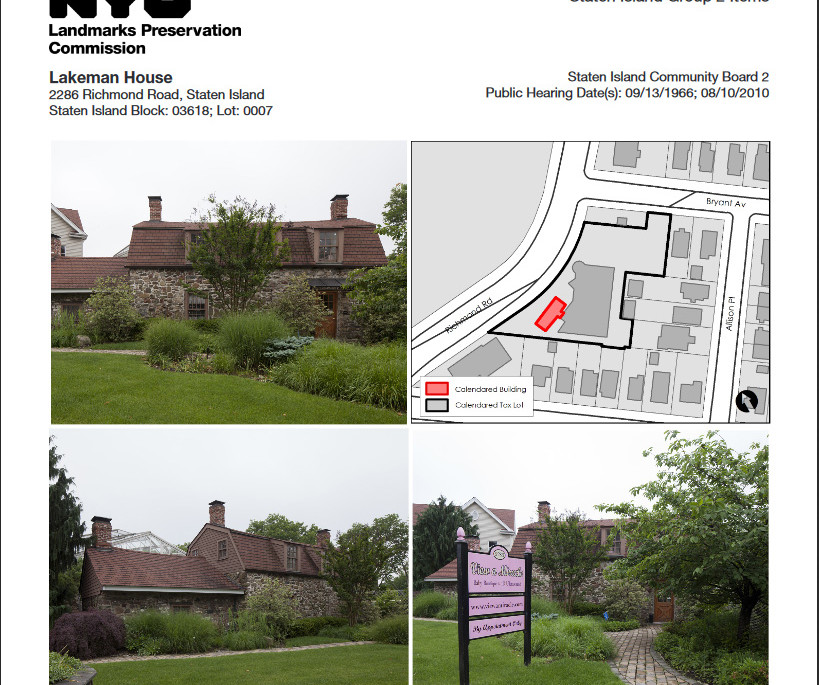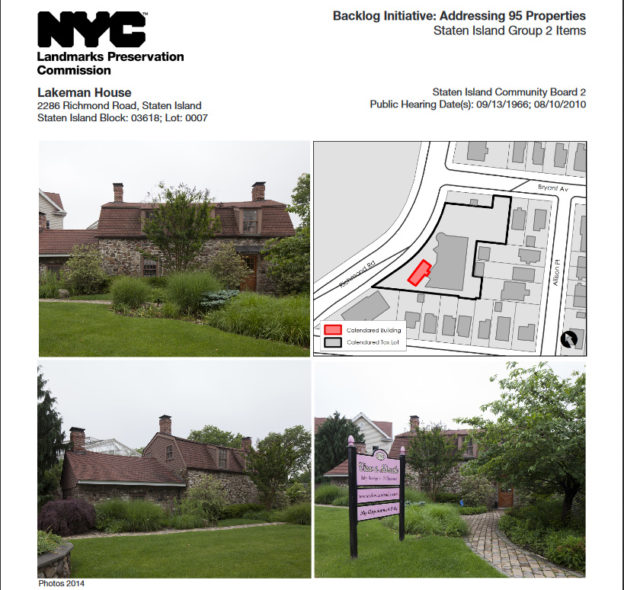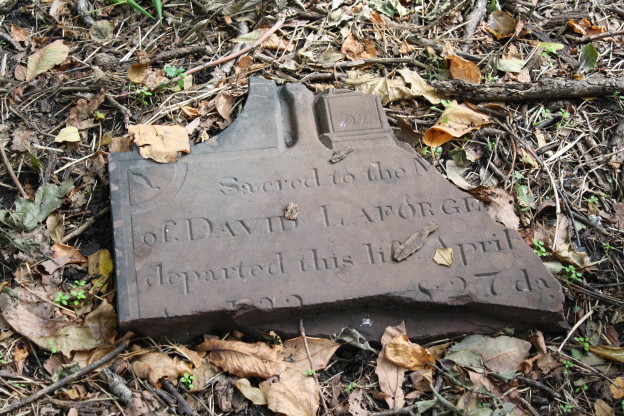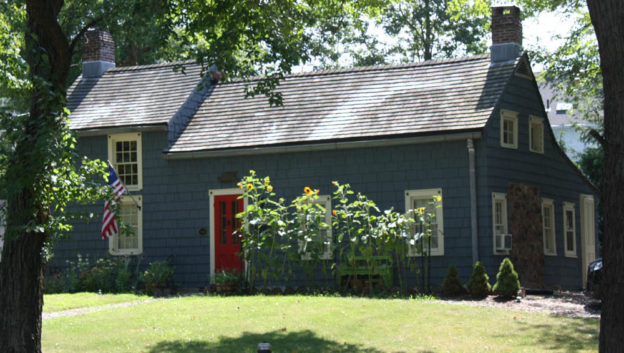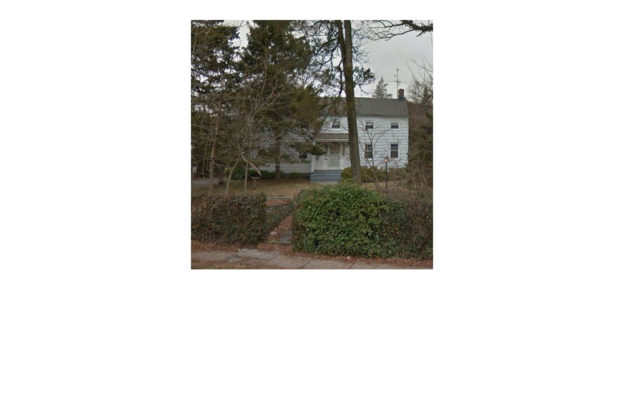Address: 2286 Richmond Road;
Architect: unknown;
Constructed: 1678;
LPC Action: Calendared in 1966;
LPC Backlog Hearing: Prioritized for designation
Designated – December 13, 2016
Designation overturned by City Council- March 28, 2017|
The Lakeman-Courtelyou-Taylor House is a stone Dutch Colonial style farmhouse that underwent extensive restorative work in 2001-02. It is likely that (up until its designation) is was the only 17th-century building on Staten Island to remain un-landmarked.
To learn more about the Lakeman-Courtelyou-Taylor House click here
Address: 234 Bard Avenue;
Architect: unknown;
Constructed: 1853;
LPC Action: Public Hearing in 1966;
LPC Backlog Hearing: Prioritized for designation|
Designated on June 28, 2016
LPC- Fact Sheet | Research File
HDC Testimony
Beyond the architectural charms of this mid-19th century farmhouse, the Curtis House is noted for its relation to hot topics of the time period. George W. Curtis was the editor of the popular political magazine “Harper’s Weekly” as well as a writer, lecturer, reformist and supporter of Abraham Lincoln. It is said that fellow abolitionist and Republican Horace Greeley hid here in the house from mobs of angry pro-South Staten Islanders. Historic detailing including brackets under the eaves and eared windowsills as well as true divided-light windows have recently been restored.
To learn more about George William Curtis House click here
Address: corner of Richmond Road and Clove Road;
Architect: N/A;
Established: 1802;
LPC Action: Calendared in 1966;
LPC Backlog Hearing: Denied|
LPC- Fact Sheet | Research File
HDC Testimony
Established as a burial ground of the Clove Baptist Church (formed in 1809 and abandoned in the 1840s), this site is quite small at roughly 100’ x 50’ in total size. There are approximately 50 burials. The Friends of Abandoned Cemeteries of Staten Island installed a sign to mark the cemetery’s location at the southwest corner of Richmond Road and Clove Road, but the site is overgrown and the grave markers are not visible from the intersection.
To learn more about the Fountain Family Graveyard click here
Address 457 Poillon Avenue;
LPC Action: Calendared in 2001;
LPC Backlog Hearing: Denied|
Fact Sheet | Research File
HDC Testimony
Despite the cultural and religious significance of the cottage inhabited by journalist and social activist Dorothy Day at Spanish Camp, its demolition after an intense preservation battle in the late 1990s and early 2000s unfortunately means there is no longer a building to designate. While the Spanish Camp is a site with multiple layers of significance, the new construction in the area has obliterated the natural setting and modest cottages. This unhappy preservation saga should stand as a warning against making non-binding agreements with real estate developers in the attempt to protect buildings.
To learn more about the Dorothy Day Historic Site click here
Address: 631 Howard Avenue;
Architect: unknown;
Constructed: c. 1852;
LPC Action: 1966;
LPC Backlog Hearing: Removed from the calendar without prejudice|
Fact Sheet | Research File
HDC Testimony
With a mission to prepare future Lutheran ministers for admission to seminary, Wagner College was founded in 1883 in Rochester, NY. The college relocated to Grymes Hill on Staten Island in 1918, acquiring the 38-acre former country estate of 19th century shipping magnate Edward Cunard, the New York representative of the famous Cunard shipping line. The estate, which overlooked New York harbor, Manhattan and the ocean, included a grand mansion called “Westwood.” The mansion is a three-story, red brick Italianate villa with a multi-gabled roofline, overhanging bracketed eaves and arched windows.
To learn more Cunard Hall click here
Address: Historic Richmond Town;
Architect: unknown;
Constructed: c. 1819;
LPC Action: Calendared in 1966;
LPC Backlog Hearing: Denied|
LPC- Fact Sheet | Research File
Staten Island native and Manhattan merchant Jacob Crocheron constructed this house at 84 Woodrow Road in Greenridge. In 1987, the Staten Island Historical Society purchased the house to prevent its demolition, and relocated it to its present location in Historic Richmond Town. The wood-frame, one-and-a-half-story farmhouse has a gambrel roof with dormers, tall brick chimneys on both side elevations, clapboard and cedar shingle cladding, and columned porches on both the front and back of the house.
To learn more about the Crocheron House click here
Address: 4745 Amboy Road;
Architect: unknown;
Constructed: early 18th century;
LPC Action: Public Hearing in 2000;
LPC Backlog Hearing: Prioritized for designation |
Designated – December 13, 2016 |
The Cottage is a living testament to the changing character of Staten Island. The most distinctive feature of its original one-story section, dating from the early part of the 18th century, is the substantial stone chimney that recalls the Island’s rural quality. Eventually, when development began in earnest, the house was used as an office to sell land for a housing development. Now located in a park, and managed by the Historic House Trust, it is deserving of landmark status for its long history, as well as its rustic charm.
To learn more about the Brougham Cottage click here
Address: 3833 Amboy Road;
Architect: unknown;
Constructed: 1843;
LPC Action: Public Hearing in 2007;
LPC Backlog Hearing: Removed from the calendar without prejudice;
LPC-Fact Sheet | Research File |
HDC Testimony
3833 Amboy Road is an increasingly rare reminder of Staten Island’s rural past. A smaller, earlier gable-roofed, clapboarded house was apparently expanded around 1840 to create an impressive farmhouse. Details were added at this time including a paneled door with sidelights, a dentilled cornice and end chimneys. Its 19th-century occupants, a farmer and later an oysterman, reflect the agricultural nature of Staten Island.
To learn more about 3833 Amboy Road the click here
Address: 92 Harrison Street;
Architect: unknown;
Constructed: ca. 1840;
LPC Action: 1980;
LPC Backlog Hearing: Prioritized for designation;
Designated on June 28, 2016;
LPC- Fact Sheet | Research File|
HDC Testimony
While Stapleton Heights boasted the mansions of Manhattan-based businessmen and officials of local breweries, Harrison Street, also located in Stapleton, was made up of the less grand, but no less dignified homes of the neighborhood’s merchants and professionals. Thanks to the efforts of dedicated homeowners, many of these “modest” homes now rival their neighbors up the hill.
The 92 Harrison Street House is an exceptionally fine and remarkably intact example of the vernacular Greek Revival style and representative of the first period of development as Harrison Street was transitioning into a village enclave.
Thought to be the oldest on the street, constructed around 1853-54 for Richard G. Smith, most likely as an investment property, the 2½ story clapboard house is sited on a large lot at the junction of Harrison and Quinn Streets making it a focal point for the immediate neighborhood. One of ten houses constructed on Harrison Street prior to 1860 as Stapleton was transitioning into a denser neighborhood, the 92 Harrison Street House is the only example of the temple form design on the street.
To learn more about 92 Harrison Street click here
Address: 34–30 to 34–52 75th Street
Architect: J. Case & Peter Schreiner
Constructed: 1927
LPC Action: Calendared: 1990
LPC Backlog Hearing: Removed from the calendar without prejudice
HDC Testimony
LPC- Fact Sheet | Research File
The Spanish Tower Homes include 10 three- and four-story detached tan brick houses. The first floors of these dwellings have no windows and instead feature French doors that open on to wrought-iron balconettes. Some windows on upper floors have original wood shutters, and the corner houses feature fourth-floor loggias. These houses have shared driveways with detached garages in the rear.
To learn more about the Spanish Towers click here
